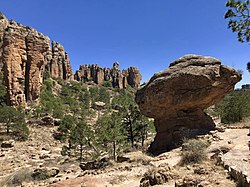Zacatecas
It is located in north-central Mexico and is bordered by the states of Durango to the northwest, Coahuila to the north, Nayarit to the west, San Luis Potosí and Nuevo León to the east, and Jalisco, Guanajuato and Aguascalientes to the south.
[8][9][10] It borders the states of Nayarit, Jalisco, Aguascalientes, San Luis Potosí, Coahuila and Durango and is divided into 58 municipalities and 4,882 towns, cities and other communities.
[11] Most of the territory has a cool, dry climate, although areas in the south have more moisture, with most rain falling between June and September.
[10][11] Ecosystems vary depending on relief, soil and temperature, leading to a wide variety of vegetation, including forests, scrub and grasslands.
[12] In the sierras there are many wild boar, white-tailed deer and hares; in the valleys and plains it is common to find coyote, badgers, quails and ducks.
The extreme northern part of the state is the southern fringe of the Chihuahuan Desert and as such is rich and diverse in biology.
[11][14] The state seal depicts the Cerro de la Bufa, a landmark of the capital, surrounded by the weapons of the original inhabitants.
Between the fourth and tenth centuries in the Christian era, several large settlements developed such as Altavista, Chalchihuites and La Quemada, considered to be part of Greater Mesoamerica.
[15][14] Areas in the north of the state, without major settlements, were part of what is called Aridoamerica, where inhabitants lived off hunting and gathering.
This settlement was later moved to its current location in Jalisco because of water supply problems and indigenous attacks.
[15] These riches supported the establishment of new settlements along with the building of elegant churches and mansions as the area became one of the most important of New Spain.
[15] For the rest of the century, the state was mostly controlled by local strongmen, such as González Ortega, Trinidad García de la Cadena and Genero Codina.
[11] The fighting depressed silver production until near the end of the century, but it recovered enough to account for sixty percent of the state's export revenue.
[15] At the end of the century, technological innovations such as the telegraph, telephone, electricity and rail lines connected the state with the rest of Mexico.
This battle pitted the troops of Francisco Villa against those of Victoriano Huerta, resulting in the deaths of 7,000 soldiers and the wounding of 5,000.
[8] Indigenous languages spoken in the state include Huichol (1000 speakers), Nahuatl (500), Tepehuan (just under 500) and Tlapanec (about 400).
The state has fifteen mining districts of which the most important are Fresnillo, Zacatecas, Concepción del Oro, Sombrerete and Chalchihuites, along with Nora de Angeles more recently.
[15] Zacatecas's economy used to be almost completely centered on mining but has since diversified into cattle raising, agriculture, communications, food processing, tourism and transportation.
Zacatecas is Mexico's main producer of beans, chili peppers, guavas and nopal, along with significant grain, sugar cane, grape and peach crops.
[29][32] Traditional handcrafts include weaving in Villa Garcia, saddles and jewelry in Jerez as well as furniture, leatherworking, miniatures, macramé, ironwork and pottery in various locations.
It also includes archeological sites such as Alta Vista and La Quemada along with thermal springs such as Paraíso Caxcan.
The Mexican Revolution took a toll on the state's local musical traditions, but one that has survived is the Tamborazo, especially in Jerez.
[11] In the state capital, September 8 is dedicated to the Virgen del Patrocinio on the Cerro de la Bufa, with various cultural and artistic events such as bullfighting, concerts, horse racing and culinary demonstrations.
The last week of August is dedicated to the Morismas de Bracho, a theatrical production of the struggle between Moors and Christians.
[35] Traditional favorite foods include gorditas and panecillos, both made from corn and can be sweet or savory, depending on the filling.
Meat is most typically prepared as part of a stew to which vegetables such as corn, chickpeas, squash, rice and more are added.
One well-known meat preparation is asado de boda, which is pork in a sauce made with mild red chili peppers.
[36] La Quemada is located fifty km south of the city of Zacatecas, the state's largest pre Hispanic settlement.
The site is noted for its pit burials as well as the oldest copper smelting facility in Mesoamerica [citation needed].
[36] It is one of several religious and population centers created by the Caxcans, who were semi nomadic, along with others in Tlaltenango, Juchipila and Teocaltiche.






